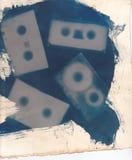blue book one: Dreamhouse
hardback 7"x7" photobook + hardback 7"x7" photobook + C30 + C30 + download code encased in a handmade wooden box
Dreamhouse consists of two high-quality photobooks and two tapes in a lovely wooden case. One book juxtaposes architectural details of men's bodies with architectural details of buildings and the other book juxtaposes architectural details of women's bodies with architectural details of buildings.
Porn, basically. For people who are sexually attracted to architecture.
Photographers featured in Dreamhouse are:
Adam Revington
Alejandra Vaculi
Alice LaComte
Andrew Schroer
Anton Novoselov
ar_graff
Artem Kolesnikov
Avard Woolaver
Barry Falk
black opal 2005
Blackstation
Catherine Mendez
Cedric Yon
Chris Friel
CM Goodenbury
David Olsson
Denis Cherim
Delay Tactics
Diane Powers
Dimas Veodovato
Douwe Dijkstra
Ece Bal
Eiko Weishaupt
Gabriel Green
Gary Poulton
Heitor Magno
Jacob Price
Jan Zimmerman
John Lamont
Jonathan Kos-Read
Juan D Quintero
Kaometet
Katie Bauer
Kenny Lok
Krystian Kujda
Larrend Lacuesta
Laurence Philomene Oliver
Louise Butterworth
Lena U
Luca Norbiato
Malte Wandel
Maria Luisa Corapi
Mariana Castro
Marquitos Sanabria
Maykel Lima
Melanie K
Michael Scholz
Minno Ramirez Terron
Miroslava Brooks
Natalie Kirk
orinoko42
Patrick Warner
Philippe Conquet
Rebecca Risjdijk
RS Nisio
Silvia Grav
Silvia Sani
Sumyko
Tim Schreier
tekktoo
Yves Castellano
The music contained on the tapes is a "soundtrack" of sorts. One tape is a mix of Blue Tapes artists Whitney George, Guzzlemug, Prayer and We are Bright & Broken. The other tape is a collage piece - called Sleeping in Houses - themed on architecture, memory and dreams, by Thank You, Merciless Onlookers.
(note: products in the 'blue book' series are not available as part of the tape subscription)
God Is In The TV review:
This is a book review. But Blue Book One: Dreamhouse is not a book. It is more like a blister-pack of coffee-table conversation pieces: a montage of photography, architecture and music entombed lovingly in a wooden box. It’s publication is an exciting one. Two books, two accompanying aural collages, and a challenge. Let’s start with the books.
Spread 7” by 7” on my desk, each page opens as a window to its opposite, mirroring images of the body with highly-textured photographs of buildings. The natural world sits on the left, from which faces and fauna draw us into a myriad of personal reflections; the urban landscape sits on the right. The juxtaposition is an obvious one – as obvious as the male-female split that separates books One and Two. But in the centre, formed in the space between like a strip of skyline between two skyscrapers, Dreamhouse draws its focus from the opposites’ point of interchange, and excels in doing so. The natural (the emotional, the sensual, the interior) is presented hand-in-hand with the designed (the powerful, the stationary, the lifeless); through this we can see each one in the light of the other. We see not just traces but unmistakable signifiers of personality in architecture: a perfect way to highlight the human personality as itself ‘designed’. Steel girders run opposite the structures of bone under skin. Through their natural counterparts, the buildings take on aspects of authority, androgyny, flair, spirituality… The photographs collide with each other, fuse with each other, fulfil and replace each other. A block of flats, the very image of immobility, is given movement by the introduction of light into its three-dimensional parameter; time provides the standstill with a story. Symmetry describes the careful selection of our clothes, our hair, our make-up: everything that aspires to the conscious image. Asymmetry catches the architecture off-guard, showing us the mutation, rupture and decay in nature and the man-made. The exterior, with a visual eloquence shared by all the photographers in the collection, gives us an insight into the interior and marries form and feeling in an unusual way. How do you feel at the foot of a skyscraper? Terror, at the immensity of its unregulated power (the Tower of Babel), or pride in its testament to the human achievement over the hostility of nature? Photographs of the body evoke similar questions: how do we respond to the perfections and imperfections of others, and what does that tell us about the way we view ourselves? The collection’s title, Dreamhouse (crossing the double-fantasy of our relationships with architecture and the subconscious), gives us a strong indication that the answers may be found, ultimately and for better or worse, in our imagination. The accompanying music, an ensemble of unorthodox instrumentation, technology, noise, and discomfort, provides us with a similar stimulus. The essence of minimalism running through much of the soundtrack does well to reflect the shrinking of music in the face of great architecture. The contemplative use of negative space turns us back towards the faces frozen as if in meditation on the left-hand page. The mixture of sounds, mostly defying conventional rhythm, supports an imaginary photomontage that, though lacking humour, responds well to the various themes of the photographs. The credit for the success of the collection as a whole, however, must lie with the photographers, whose composition can only be described as ecstatic.
Dreamhouse screams to us a simple fact: the world is urban. We are born into it; the city has become our natural environment. It is no wonder then that we should be a reflection of our architecture as much as our architecture should be a reflection of us. The urban environment is an extension of the natural world; it is a human gesture, an expression of our biological selves. The Dreamhouse photographs, capturing this aspect of modernity exquisitely, tell a story of which we are all a part. Its role is to place this story onto the coffee-table, and to open a discussion. The price of such a portfolio is, unsurprisingly, steep, and the publication may find itself spread mainly in the lobbies of photography studios and design firms, but regardless, the work makes a lasting impression. It is an archive of meaning in life, and as such, deserves the highest respect.





